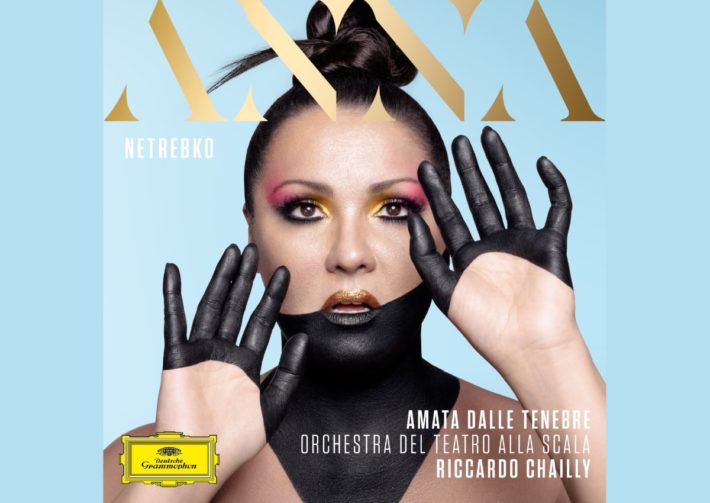Amata dalla Tenebre is Anna Netrebko’s first solo album in five years and an ambitious one at that: featuring a collection of some of the greatest soprano arias, the album showcases heroines on the cusp of love and death. Netrebko admits that the works she presents is demanding, requiring nothing short of a change of vocal technique for each composer. And so, the stakes are high: how effectively does she portray these women in their most defining moments? And how does the album hold up to a much-anticipated wait?
Dido’s Lament from Purcell (track 3) shows Netrebko’s versatility, as she takes on heavier vocal qualities one might associate with a mezzo. She creates a richness which underscores the funereal tragedy. That’s not to say the soprano doesn’t make her appearance: she does as in 1:54, her voice taking on an angularity to express Dido’s pain. Despite the lament’s relative quietness, there are an abundance of sensitivities: in changing the gradients of the dynamics so seamlessly, she creates a buildup of tension and emotion that feels very natural.
Puccini’s Un bel di vedremo (track 11) offers the marked contrast in vocal color and technique that Netrebko mentions in the liner notes. Her dark and husky timbre in the Purcell is replaced by a vibrancy that fits right into the verismo genre. The interpretation brings something new in its mindful attention to Madame Butterfly’s complexity: forlorn she is, but there are two distinct aspects to her yearning. In the aria’s most powerful moments, it is achingly desperate but in the softer ones, becomes intimate and vulnerable. (Here, one can’t help but hear reminiscences of the late 1950s Maria Callas performance with Karajan and La Scala–Netrebko’s voice is a little more silvery, but both sopranos bring out incredibly expressive subtleties). Netrebko’s vibratos take us just to the brink of raw heartache while sustained phrases throughout help with the aria’s expansive and melodious qualities. Chailly and the instrumentalists are mindful throughout to support the soloist, which makes her nuances come through even more saliently.
Related Classical Music Reviews
- Review: “Anima Rara” – Ermonela Jaho, Soprano
- Review: “I am Hera” – Hera Hyesang Park, Soprano
- Review: “El Nour” – Fatima Said, Soprano
Sola, Perduta, Abbandonata (track 9) is for me one of the most dynamic performances on the album. Putting the flexibility of her technique on full display, Netrebko extracts pure drama in the explosive bursts of Manon’s despair. Not to be missed are also lovely collaborative moments between Netrebko and the winds at the beginning which brings the poignancy to new heights.
Both singer and orchestra save the best for last with a rousing performance of Isolde’s Liebestod (track 18). This aria is all about the heroine’s anticipation – of death, that is – and the music speaks powerfully to this: drawn-out phrases and a slow, yet simmering ascent are all part of the grandiose suspense. Isolde might be a tragic character, but Netrebko’s account digs deep to reveal dignity in her final moments. Voice control is superb here – over the course of seven and half minutes, the singer not only maintains the long lines consistently but manages to infuse them with an ever-increasing intensity. The orchestra also observes a well-calibrated pacing of the dramatic momentum, but knows when to let go: the climactic moment is thunderous and impressive.
While Netrebko shines throughout, there’s a good reason that she credits Chailly as a guide through each aria. The conductor clearly understands not just the music itself from the vocal perspective, he is also cognizant of the singer’s personal approach, knowing almost inherently when to hold back and when to bolster.
On a first glance, the liner notes seem disappointingly short, but a read reveals a compact narrative. It ties together the women of the operas as well as the way Netrebko aims to embody them. The sound engineering matches up in quality as well with a sensible balance of forces maintained, even in the orchestrally denser selections by Puccini or Wagner.
Netrebko’s aim, she says, is to become the characters she portrays. This album proves just that and more – how deeply she goes into each heroine’s psyche. The result is a multidimensional and riveting portrayal of each woman in her deepest moments of conflict.

Amata dalla Tenebre
Anna Netrebko – Soprano
Orchestra del Teatro alla Scala
Riccardo Chailly – Conductor
Deutsche Grammophon, CD 4860531
Recommended Comparisons
Read more classical music reviews or visit The Classic Review Amazon store
Follow Us and Comment:
[wd_hustle id=”HustlePostEmbed” type=”embedded”]











